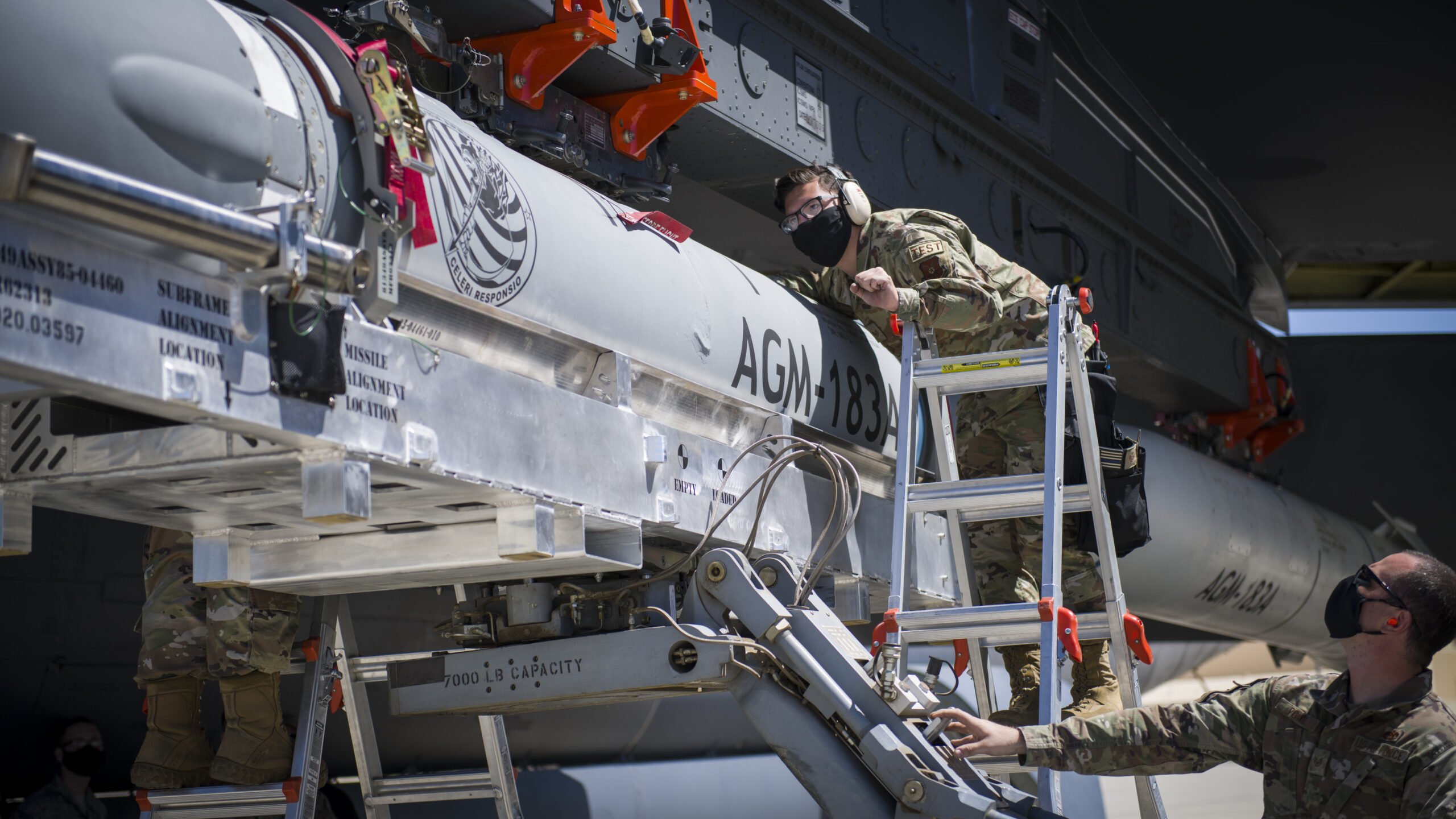
Staff Sgt. Jacob Puente, 912th Aircraft Maintenance Squadron, helps line up the AGM-183A Air-launched Rapid Response Weapon Instrumented Measurement Vehicle 2 as it is loaded under the wing of a B-52H Stratofortress at Edwards Air Force Base, California, Aug. 6, 2020. (Air Force/Giancarlo Casem)
EGLIN AIR FORCE BASE, Fla.: The Air Force is gearing up to choose a company to develop and build a hypersonic cruise missile by the end of September, the service’s program executive for weapons told Breaking Defense in an exclusive interview.
Raytheon, Lockheed Martin and Boeing are expected to complete preliminary designs for the Hypersonic Attack Cruise Missile (HACM) this fiscal year, which ends on Sept. 30. That will give the Air Force enough information to decide which of the top missile manufacturers will move on to the next phase of the program, said Brig. Gen. Heath Collins, program executive officer for weapons.
“Later this summer or later fall, given all this data coming together, will be when we would be looking to make a decision,” he told Breaking Defense.
RELATED: DARPA hypersonic cruise missile prototype flies at last
Because the Air Force is currently in “source selection” for HACM — a sensitive stage in the acquisition process where it is analyzing proposals from bidders — Collins couldn’t say much about the companies’ offerings. However, he said that the systems requirements review for the program completed on schedule last year and that the development effort, although nascent, was “going pretty well.”
Despite its senior leader’s public hesitancy regarding hypersonic strategy, the Air Force’s confidence in hypersonic cruise missile technology appears to be growing. The service requested $316.8 million in its fiscal 2023 budget submission — an increase of almost $257 million over its funding for FY22.
According to the budget, the HACM vendor will progress to the critical design review stage in FY23, where it will continue “the assembly, integration and test of subsystems for qualification testing, as well as prototype systems for system qualification, ground test and flight testing.”
Unlike the AGM-183A Air-Launched Rapid Response Weapon (ARRW) — a boost-glide hypersonic missile that is further along in development — HACM will use air-breathing propulsion such as a scramjet to reach five times the speed of sound. Hypersonic cruise missiles like HACM are expected to be smaller and less expensive than boost-glide variants, allowing the Air Force to fit more missiles onto a wider variety of aircraft.
In April, Air Force Chief of Staff Gen. CQ Brown told lawmakers that the latest Boeing F-15EX model would carry HACM, while the budget states that integration of the weapon will first be done on the F-15E Strike Eagle to enable HACM to move quickly to flight tests.
ARRW Flies Forward Into Cloudy Skies
For the Lockheed Martin-made ARRW, which logged its first successful booster test earlier this week after three failed tests last year, its ultimate future is still uncertain.
During the May 14 test, the ARRW missile met all its primary and secondary objectives, which were focused on the performance of the booster and the missile’s separation from the B-52 that launched it, Collins said.
“All of that looks to have worked,” he said. “Of course, now the data crunching has to go on. The team is still very much taking a look into the inner workings of the details, but the flight path [and] everything looks good.”
If all goes well during a second booster flight test this summer, ARRW will progress into all-up round testing, where the missile will be tested in its final, fully-assembled form. A first all-up round launch is scheduled to occur by the end of 2022, Collins said.
While the Air Force plans to do four all-up round tests during the course of fiscal year 2023, it will technically have the data it needs to make a production decision by the end of December, after the first all-up round test and the completion of a Production Readiness Review that ensures that Lockheed and its suppliers are ready to manufacture the new weapon.
However, Air Force Secretary Frank Kendall has voiced concerns about the Defense Department’s approach to hypersonic weapons, stating that the Air Force should be careful not to replicate expensive capabilities that China and Russia have that may only marginally push forward the service’s advantage.
Even if ARRW moves through its next two test launches smoothly, Kendall could choose to wait until all flight tests are complete before committing to making ARRW a program of record.
And even if ARRW is successful in all future testing, Kendall could still opt to cancel the program if it doesn’t match the service’s requirements or budget, Collins acknowledged.
“He wants us to execute and buy down the risk and show that we we’ve demonstrated capability. [But] a lot of the questions he’s been asking in public and within the Air Force is, what are the unique target sets that ARRW holds down and is it worth the cost of the rounds?” he said. “He’s asking for the business case.”
Boeing buys GKN factory, ending dispute over F-15, F/A-18 parts
Through the deal, Boeing’s litigation with supplier GKN Aerospace will be dropped, and the aerospace giant will take possession of a St. Louis-area factory it used to own.


























